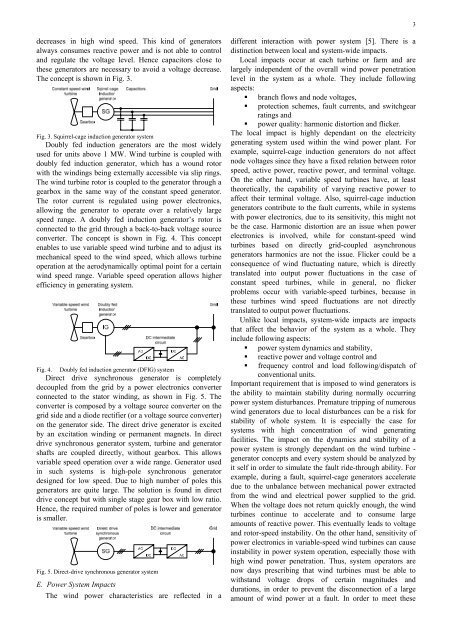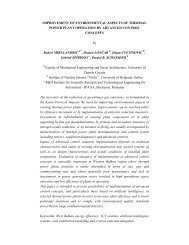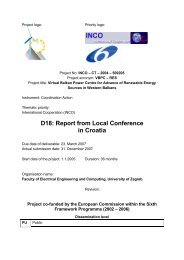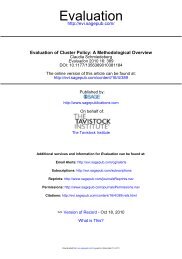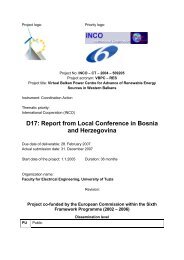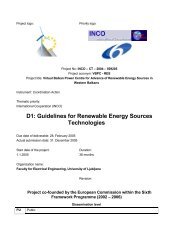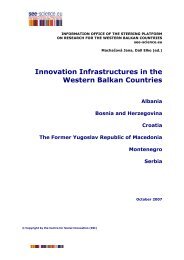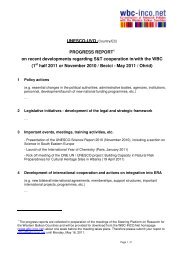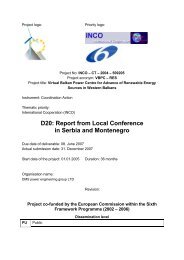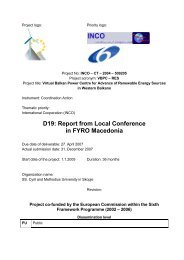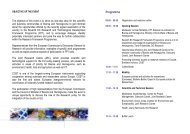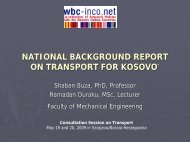Prva stran - WBC-INCO Net
Prva stran - WBC-INCO Net
Prva stran - WBC-INCO Net
You also want an ePaper? Increase the reach of your titles
YUMPU automatically turns print PDFs into web optimized ePapers that Google loves.
decreases in high wind speed. This kind of generators<br />
always consumes reactive power and is not able to control<br />
and regulate the voltage level. Hence capacitors close to<br />
these generators are necessary to avoid a voltage decrease.<br />
The concept is shown in Fig. 3.<br />
Fig. 3. Squirrel-cage induction generator system<br />
Doubly fed induction generators are the most widely<br />
used for units above 1 MW. Wind turbine is coupled with<br />
doubly fed induction generator, which has a wound rotor<br />
with the windings being externally accessible via slip rings.<br />
The wind turbine rotor is coupled to the generator through a<br />
gearbox in the same way of the constant speed generator.<br />
The rotor current is regulated using power electronics,<br />
allowing the generator to operate over a relatively large<br />
speed range. A doubly fed induction generator’s rotor is<br />
connected to the grid through a back-to-back voltage source<br />
converter. The concept is shown in Fig. 4. This concept<br />
enables to use variable speed wind turbine and to adjust its<br />
mechanical speed to the wind speed, which allows turbine<br />
operation at the aerodynamically optimal point for a certain<br />
wind speed range. Variable speed operation allows higher<br />
efficiency in generating system.<br />
Fig. 4. Doubly fed induction generator (DFIG) system<br />
Direct drive synchronous generator is completely<br />
decoupled from the grid by a power electronics converter<br />
connected to the stator winding, as shown in Fig. 5. The<br />
converter is composed by a voltage source converter on the<br />
grid side and a diode rectifier (or a voltage source converter)<br />
on the generator side. The direct drive generator is excited<br />
by an excitation winding or permanent magnets. In direct<br />
drive synchronous generator system, turbine and generator<br />
shafts are coupled directly, without gearbox. This allows<br />
variable speed operation over a wide range. Generator used<br />
in such systems is high-pole synchronous generator<br />
designed for low speed. Due to high number of poles this<br />
generators are quite large. The solution is found in direct<br />
drive concept but with single stage gear box with low ratio.<br />
Hence, the required number of poles is lower and generator<br />
is smaller.<br />
Fig. 5. Direct-drive synchronous generator system<br />
E. Power System Impacts<br />
The wind power characteristics are reflected in a<br />
different interaction with power system [5]. There is a<br />
distinction between local and system-wide impacts.<br />
Local impacts occur at each turbine or farm and are<br />
largely independent of the overall wind power penetration<br />
level in the system as a whole. They include following<br />
aspects:<br />
branch flows and node voltages,<br />
protection schemes, fault currents, and switchgear<br />
ratings and<br />
power quality: harmonic distortion and flicker.<br />
The local impact is highly dependant on the electricity<br />
generating system used within the wind power plant. For<br />
example, squirrel-cage induction generators do not affect<br />
node voltages since they have a fixed relation between rotor<br />
speed, active power, reactive power, and terminal voltage.<br />
On the other hand, variable speed turbines have, at least<br />
theoretically, the capability of varying reactive power to<br />
affect their terminal voltage. Also, squirrel-cage induction<br />
generators contribute to the fault currents, while in systems<br />
with power electronics, due to its sensitivity, this might not<br />
be the case. Harmonic distortion are an issue when power<br />
electronics is involved, while for constant-speed wind<br />
turbines based on directly grid-coupled asynchronous<br />
generators harmonics are not the issue. Flicker could be a<br />
consequence of wind fluctuating nature, which is directly<br />
translated into output power fluctuations in the case of<br />
constant speed turbines, while in general, no flicker<br />
problems occur with variable-speed turbines, because in<br />
these turbines wind speed fluctuations are not directly<br />
translated to output power fluctuations.<br />
Unlike local impacts, system-wide impacts are impacts<br />
that affect the behavior of the system as a whole. They<br />
include following aspects:<br />
power system dynamics and stability,<br />
reactive power and voltage control and<br />
frequency control and load following/dispatch of<br />
conventional units.<br />
Important requirement that is imposed to wind generators is<br />
the ability to maintain stability during normally occurring<br />
power system disturbances. Premature tripping of numerous<br />
wind generators due to local disturbances can be a risk for<br />
stability of whole system. It is especially the case for<br />
systems with high concentration of wind generating<br />
facilities. The impact on the dynamics and stability of a<br />
power system is strongly dependant on the wind turbine -<br />
generator concepts and every system should be analyzed by<br />
it self in order to simulate the fault ride-through ability. For<br />
example, during a fault, squirrel-cage generators accelerate<br />
due to the unbalance between mechanical power extracted<br />
from the wind and electrical power supplied to the grid.<br />
When the voltage does not return quickly enough, the wind<br />
turbines continue to accelerate and to consume large<br />
amounts of reactive power. This eventually leads to voltage<br />
and rotor-speed instability. On the other hand, sensitivity of<br />
power electronics in variable-speed wind turbines can cause<br />
instability in power system operation, especially those with<br />
high wind power penetration. Thus, system operators are<br />
now days prescribing that wind turbines must be able to<br />
withstand voltage drops of certain magnitudes and<br />
durations, in order to prevent the disconnection of a large<br />
amount of wind power at a fault. In order to meet these<br />
3


